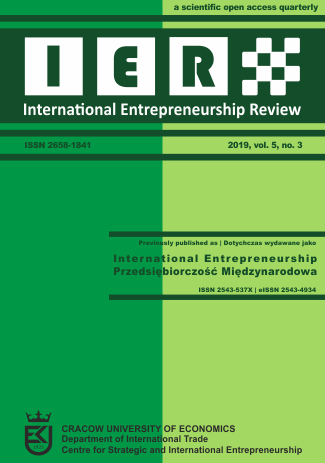Entrepreneurship development in Japan: An empirical analysis

Abstract
Objective: The purpose of this article is to evaluate the entrepreneurship development of Japan and comparing its performance against leading countries in the same region, mainly Hong Kong, and Taiwan.
Research Design & Methods: We implement the Global Entrepreneurship Index GEI methodology, where the GEI methodology focuses on quality-related institutional and individual aspects of entrepreneurship. Moreover, we utilised a novel feature of the GEI the Penalty for Bottleneck PFB methodology to produce induction of which entrepreneurial elements should be addressed and how much effort needs it to lighten Japan bottleneck.
Findings: Japan’s entrepreneurial performance is relatively modest compared to some countries in the same region, especially in individual variables. Japan’s entrepreneurial profile strengths are in the institutional features (e.g., country risk), while the instability in the profile back to individual variables (e.g., population perception and motivation). The country has three fundamental bottlenecks in its performance opportunity perception, start-up skills, and networking pillars. The GEI data used in the study only covers the 2006-2016 period. Japan should be focused on the three bottlenecks opportunity
perception, start-up skills, and networking to improve its entrepreneurial performance by developing an education policy that focuses on entrepreneurship.
Contribution & Value Added: This paper identifies the vulnerable aspects of Japan’s performance by using a novel methodology that combines individual and institutional variables in a single model. Also, the use of (PFB) to detect which entrepreneurial components should be addressed.
Author Biography
Tareq Lubbadeh
Tareq Lubbadeh is a Ph.D. Student in the Program in Business Administration at the University of Pécs. He holds an MBA degree from Al- Balqa’ Applied University (BAU), Amman, Jordan. In his doctoral research, he focuses on the relation between job Burnout and employee performance. Tareq has a genuine interest in combining the art and science of psychology with useful and practical business applications to improve the work environment.
References
- Acs, Z. J., Autio, E., & Szerb, L. (2014). National Systems of Entrepreneurship: Measurement issues and policy implications. Research Policy, 43(3), 476-494. https://doi.org/10.1016/j.respol.2013.08.016
- Acs, Z. J., Rappai, G., & Szerb, L. (2011). Index-Building in a System of Interdependent Variables: The Penalty for Bottleneck. GMU School of Public Policy Research Paper, 2011-24. https://doi.org/10.2139/ssrn.1945346
- Acs, Z.J., & Szerb, L. (2009). The Global Entrepreneurship Index (GEINDEX). Foundations and Trends in Entrepreneurship, 5(5), 341-435. https://doi.org/10.1561/0300000027
- Acs, Z.J., Szerb, L., Lafuente, E., & Lloyd, A. (2018). Global Entrepreneurship Index 2018. Cham: Springer Briefs in Economics. doi:10.1007/978-3-030-03279-1
- Acs, Z. J., Szerb, L., & Lloyd, A. (2017). Global Entrepreneurship and Development Index 2017. Cham: Springer Briefs in Economics. https://doi.org/10.1007/978-3-319-65903-9
- Aoyama, Y. (2009). Entrepreneurship and Regional Culture : The Case of Hamamatsu and Kyoto. Regional Studies, 43(3), 495–512. https://doi.org/10.1080/00343400902777042
- Bosma, N. (2013). The Global Entrepreneurship Monitor (GEM) and its impact on entrepreneurship research. Foundations and Trends in Entrepreneurship, 9(2), 143-248. https://doi.org/10.1561/0300000033
- Bosma, N., & Kelley, D. (2018). Global Entrepreneurship Monitor: 2018/2019 Global Report. Retrieved on October 23, 2019 from http://www.gemconsortium.org/report/50012
- GEM. (2018). Total Early-Stage Entrepreneurial Activity (TEA), % Of 18-64 Population (2001-2018). Retrieved on October 31, 2019 from https://www.gemconsortium.org/data/key-aps
- Honjo, Y. (2015). Why are entrepreneurship levels so low in Japan? Japan & The World Economy, 36, 88–101. https://doi.org/10.1016/j.japwor.2015.08.002
- Kegel, P. (2016). A Comparison of Startup Entrepreneurial Activity Between the United States and Japan. Journal of Management Policy and Practice, 17(1), 18-26. https://doi.org/10.33423/jmpp.v17i1.1819
- Martin, J. R. G. (2019). Impact of Cultural Factors on Entrepreneurship: Evidence From GEM Model and the Singularity of Japan. In N. Baporikar (Ed.), Handbook of Research on Ethics, Entrepreneurship, and Governance in Higher Education (pp. 433-454). IGI Global. https://doi.org/10.4018/978-1-5225-5837-8.ch020
- Marvel, M.R. (Ed.). (2012). Encyclopedia of New Venture Management. Los Angeles: SAGE. https://doi.org/10.4135/9781452218571
- Nakayama, T. (2016). Entrepreneurial Intention in Japan: An Empirical Study on Japanese University Students. International Journal of Business and General Management, 5(3), 81-94.
- OECD. (2019a). Gross domestic product (GDP) (indicator). https://doi.org/10.1787/dc2f7aec-en
- OECD. (2019b). Gross domestic spending on R&D (indicator). https://doi.org/10.1787/d8b068b4-en
- Reynolds, P., Bosma, N., Autio, E., Hunt, S., De Bono, N., Servais, I., … Chin, N. (2005). Global entrepreneurship monitor: Data collection design and implementation 1998-2003. Small Business Economics, 24(3), 205–231. https://doi.org/10.1007/s11187-005-1980-1
- Reynolds, P., Camp, M., Bygrave, W.D., Autio, E., & Hay, M. (2002). Global Entrepreneurship Monitor : 2001 Executive Report. https://doi.org/10.13140/RG.2.1.2501.3286
- Shinato, T., Kamei, K., & Dana, L. P. (2013). Entrepreneurship education in Japanese universities – how do we train for risk taking in a culture of risk adverseness? International Journal of Entrepreneurship and Small Business, 20(2), 184-202. https://doi.org/10.1504/IJESB.2013.056278
- Singer, S., Herrington, M., & Menipaz, E. (2018). Global Entrepreneurship Monitor: 2017/2018 Report. https://doi.org/10.7507/1002-1892.201706082
- Sternberg, R., & Wennekers, S. (2005). Determinants and effects of new business creation using global entrepreneurship monitor data. Small Business Economics, 24(3), 193-203. https://doi.org/10.1007/s11187-005-1974-z
- Szerb, L., Komlosi, E., & Pager, B. (2016). Measuring Entrepreneurship and Optimizing Entrepreneurship Policy Efforts in the European Union. CESifo DICE Report, 114(3), 8-23. Retrieved on July 2, 2019 from https://www.econstor.eu/bitstream/10419/167269/1/ifodice-report-v14-y2016-i3-p08-23.pdf
- Szerb, L., & Trumbull, W. N. (2018). Entrepreneurship development in Russia: is Russia a normal country? An empirical analysis. Journal of Small Business and Enterprise Development, 37(11), 572–576. https://doi.org/10.1108/JSBED-01-2018-0033
- Tilak, J.B.G. (2002). Building Human Capital in East Asia: What Others Can Learn. The International Bank for Reconstruction and Development, Washington D.C : The World Bank.
- World Bank. (2019a). GDP, PPP (current international $) - Japan [Data file]. Retrieved on October 3, 2019 from https://data.worldbank.org/indicator/NY.GDP.MKTP.PP.CD?locations=JP
- World Bank. (2019b). Research and development expenditure (% of GDP) – Hong Kong SAR, China, Japan, Korea, Rep. [Data file]. Retrieved on November 27, 2019 from https://data.worldbank.org/indicator/GB.XPD.RSDV.GD.ZS?locations=HK
- World Bank. (2019c). Self-employed, total (% of total employment) (modeled ILO estimate) – Japan [Data file]. Retrieved on October 31, 2019 from https://data.worldbank.org/indicator/SL.EMP.SELF.ZS?locations=JP
